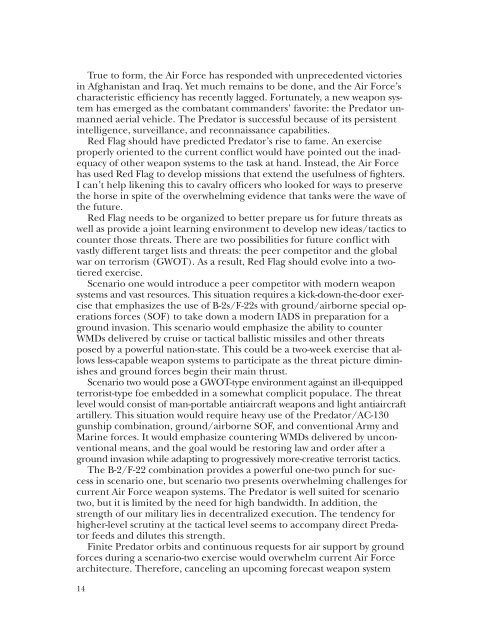Fall 2006 - Air & Space Power Chronicle - Air Force Link
Fall 2006 - Air & Space Power Chronicle - Air Force Link
Fall 2006 - Air & Space Power Chronicle - Air Force Link
Create successful ePaper yourself
Turn your PDF publications into a flip-book with our unique Google optimized e-Paper software.
True to form, the <strong>Air</strong> <strong>Force</strong> has responded with unprecedented victoriesin Afghanistan and Iraq. Yet much remains to be done, and the <strong>Air</strong> <strong>Force</strong>’scharacteristic efficiency has recently lagged. Fortunately, a new weapon systemhas emerged as the combatant commanders’ favorite: the Predator unmannedaerial vehicle. The Predator is successful because of its persistentintelligence, surveillance, and reconnaissance capabilities.Red Flag should have predicted Predator’s rise to fame. An exerciseproperly oriented to the current conflict would have pointed out the inadequacyof other weapon systems to the task at hand. Instead, the <strong>Air</strong> <strong>Force</strong>has used Red Flag to develop missions that extend the usefulness of fighters.I can’t help likening this to cavalry officers who looked for ways to preservethe horse in spite of the overwhelming evidence that tanks were the wave ofthe future.Red Flag needs to be organized to better prepare us for future threats aswell as provide a joint learning environment to develop new ideas/tactics tocounter those threats. There are two possibilities for future conflict withvastly different target lists and threats: the peer competitor and the globalwar on terrorism (GWOT). As a result, Red Flag should evolve into a twotieredexercise.Scenario one would introduce a peer competitor with modern weaponsystems and vast resources. This situation requires a kick-down-the-door exercisethat emphasizes the use of B-2s/F-22s with ground/airborne special operationsforces (SOF) to take down a modern IADS in preparation for aground invasion. This scenario would emphasize the ability to counterWMDs delivered by cruise or tactical ballistic missiles and other threatsposed by a powerful nation-state. This could be a two-week exercise that allowsless-capable weapon systems to participate as the threat picture diminishesand ground forces begin their main thrust.Scenario two would pose a GWOT-type environment against an ill-equippedterrorist-type foe embedded in a somewhat complicit populace. The threatlevel would consist of man-portable antiaircraft weapons and light antiaircraftartillery. This situation would require heavy use of the Predator/AC-130gunship combination, ground/airborne SOF, and conventional Army andMarine forces. It would emphasize countering WMDs delivered by unconventionalmeans, and the goal would be restoring law and order after aground invasion while adapting to progressively more-creative terrorist tactics.The B-2/F-22 combination provides a powerful one-two punch for successin scenario one, but scenario two presents overwhelming challenges forcurrent <strong>Air</strong> <strong>Force</strong> weapon systems. The Predator is well suited for scenariotwo, but it is limited by the need for high bandwidth. In addition, thestrength of our military lies in decentralized execution. The tendency forhigher-level scrutiny at the tactical level seems to accompany direct Predatorfeeds and dilutes this strength.Finite Predator orbits and continuous requests for air support by groundforces during a scenario-two exercise would overwhelm current <strong>Air</strong> <strong>Force</strong>architecture. Therefore, canceling an upcoming forecast weapon system14
















